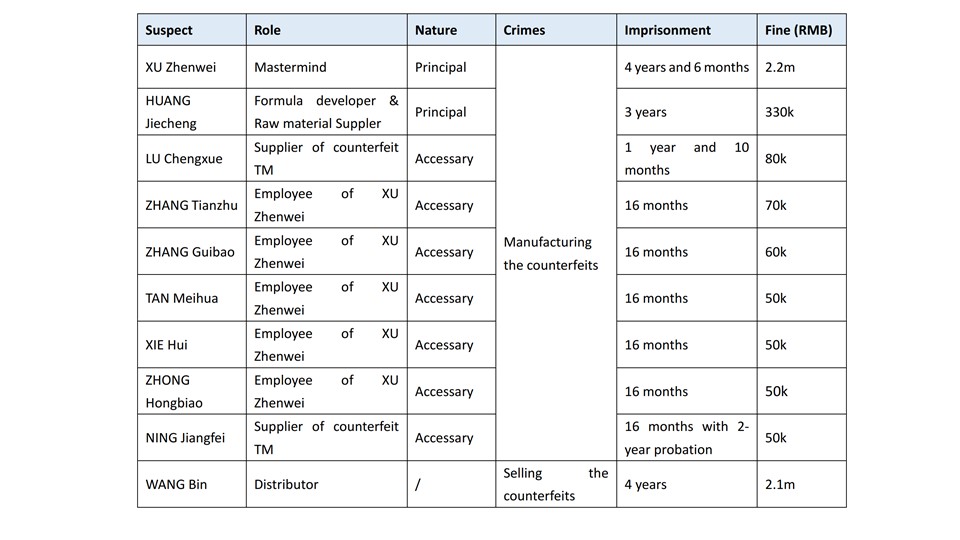Resources
Jul 21,2020
Newsletter n° 6 WHD Case: TM | SPC 50 Exemplary IPR cases of 2019 - No 49: XU Zhenwei et al. counterfeiting registered trademark
Facts:
In March 2018, L’Oréal found that several on-line Taobao stores were selling counterfeit Kiehl’s cosmetics. Afterwards, based on the intelligence supplied by Alibaba, L’Oréal filed a complaint with the Shanghai Public Security Bureau (PSB) and convinced the PSB to conduct a comprehensive investigation.
After thorough investigation conducted in 9 cities from April to June 2018, the PSB identified a syndicate manufacturing and selling counterfeit cosmetics, under the direction of an individual named XU Zhenwei. XU orchestrated the whole operation, hiring formula developers, mould makers and printers for fake labels, and having his employees manufacturing counterfeit cosmetics, which were later shipped to downstream distributors for sale.
On July 3, 2018, the Shanghai PSB together with the PSB authorities in 4 provinces launched a coordinated raid operation against 16 targets, including: two factories, two counterfeit trademark printing factories and two warehouses in Guangdong, and eight warehouses and dens located in Shanghai, Zhejiang, and Anhui. The action led to the arrestation of 13 suspects and seizure of substantial amounts of counterfeits, including 22,600 bottles of fake “Kiehl's” and “LaboLabo” cosmetics, around 360,000 pieces of fake labels, more than 10,000 fake bottles and a few equipments, with a total case value exceeding RMB 4 million.
The suspects were prosecuted and tried before the Shanghai No.3 Intermediate Court.
As the mastermind of the syndicate, XU Zhenwei was affirmed as the principal culprit for manufacturing the counterfeits and his sentence was proportionate to the total value (RMB 4.6 million) of the case: four and a half years imprisonment and a fine of RMB 2.2 million.
As to the other suspects, although some were not directly engaged in manufacturing the counterfeits, considering that they shared with XU Zhenwei a common intent to commit the crime and supplied assistance, they were deemed as joint offenders:
- HUANG Jiecheng was the formula developer and raw material supplier. Considering those are essentials for the manufacture of the counterfeits, he played an important and dominant role in the syndicate and was deemed as a principal as well : three years imprisonment and RMB 330,000 fine.
- The suppliers of the counterfeit trademarks pleaded guilty to the minor crime of manufacturing the counterfeit trademark, but not guilty to the crime of manufacturing the counterfeits. However, given the circumstances, they were deemed to be joint offenders for the crime of manufacturing the counterfeits but in an accessory role. They also received jail punishments and fines (see below).
- The other employees of XU Zhenwei, although they were affirmed as accessory, given that they did not get direct profit from the crimes but only receive a salary, their roles were deemed relatively minor and they were granted some leniency.
- The distributor WANG Bin, who committed the crime of selling the counterfeits was fined an amount i.e. RMB 2.1 million.
At last, the court made the sentences as follows:

Comments
The main challenges brand owners face in combating counterfeiting syndicate lie in: 1) how to uproot the whole network and 2) how to maximize the deterrence effect:
1. In the investigation stage, make use of the “big data” of the online marketplace as leverage to convince the PSB to launch a comprehensive investigation
The mastermind of the syndicate usually hides very deep in the backstage. Take this case as example, XU Zhenwei 1) did not operate online or brick-and-mortar store by himself, 2) rent the workshop of another factory for manufacture, and 3) only sold the counterfeits to familiar distributors. Digging out such suspect largely relies on the advanced investigation means and power of the PSB.
The challenge is to supply sufficient prima facie evidence to the PSB to justify an in-depth investigation on a valuable target. Otherwise, the PSB may not be incentivized to launch a further investigation.
Using “big data” to map out a possible network and verify the sale of counterfeits by test purchase can serve as a good leverage to convince the PSB to look into the case.
2. In the prosecution stage, the brand owner needs to entrust attorney to join the proceedings and assist the procuratorate and the court in ascertaining the facts.
Successful raid actions and big seizures do not necessarily guarantee a rigorous sentence against the infringers, as numerous elements may affect the final sentence, such as the case value, the role played, whether there is a confession or not, the payment of a fine or not, etc.
The presence of an attorney in the proceedings as the agent of the victim is crucial. The attorney can represent the victim and push for a strong punishment. Besides, the attorney can obtain the case dossier, which includes the investigation results of the PSB. The information, which contain the sales record and property sightings, can not only facilitate the assessment of case value in the criminal prosecution, but also help secure a favourable decision in a civil litigation.
Contributed by: Wei He
